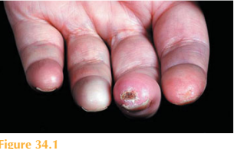History
A 54-year-old woman presents to the dermatology out-patient clinic with a two-year history of a gradual tightening of the skin over her fingers, forearms and legs. She also describes intermittent swelling of the hands and feet. Since her early 30s she had experi-enced pain in her digits on exposure to cold weather. Over the past few months she had noticed shortness of breath on exertion.
Examination
The skin over her fingers and hands appears oedematous, waxy, shiny, and indurated; normal skin elasticity has been lost. The distal fingers appear tapered and there is a small ulcer present on one of her finger pulps (Fig. 34.1). She has periorbital oedema and evidence of facial telangiectasia. On respiratory examination there are fine inspiratory crackles in the bilateral lower zone.

Questions
• What is the unifying diagnosis?
• Which organs may be involved?
• How should this patient be managed?
This patient was diagnosed with systemic sclerosis, which is a multisystem disease char-acterized by fibrotic and vascular abnormalities in association with autoimmune changes. This particularly affects the skin, lungs, heart and gastrointestinal tract.
The earliest skin changes are usually swelling of the hands and feet. Prior to this, how-ever, patients may describe a long history of Raynaud’s phenomenon, which is char-acterized by the fingers/toes undergoing a triphasic colour change from pallor (white), cyansois (blue) and rubor (red) following exposure to the cold. This occurs due to episodes of vasospasm, which causes peripheral vessels to constrict.
In association with intermittent hand and foot swelling are telangiectasia, which are visible dilated blood vessels occurring on the hands, face and chest. The hands have a characteristic appearance as in this patient including thickening of the skin over the fin-gers, which eventually leads to scarring (sclerosis). Fingers then become spindle-shaped with tapering, termed sclerodactyly, and feel tight and stiff. Skin tightening can result in difficulty opening the mouth (microstomia) and a ‘beak-like’ pinched appearance of the nose. Other late changes include finger pulp ulcers and even loss of digits.
This is a multisystem disorder affecting the gastrointestinal tract including oesopha-geal reflux, constipation, diarrhoea and malabsorption. Cardiorespiratory involvement includes pulmonary fibrosis and pericarditis. Renal involvement affects 50 per cent of patients. Joint and muscle pain occurs along with weakness and limited movement, resulting in contractures.
The diagnosis is generally made from the patient’s clinical history and examination of the skin and other organs. Up to 90 per cent of patients have elevated antinuclear antibodies (ANA). Anticentromere antibodies are characteristic. Scl-70 is unique to systemic sclero-sis and is more likely to be associated with severe systemic sclerosis involving the lungs.
Management of systemic sclerosis is challenging with as yet no cure. The course of this disease is progressive. Patients should be advised to keep their hands and feet warm with special warming gloves and fleecy boots. Vasodilating drugs and calcium channel block-ing drugs may be beneficial. H2-blockers may reduce the gastrointestinal symptoms. Oral corticosteroids, cyclophosphamide and tacrolimus may be of benefit for limited periods. D-penicillamine may also help. Renal disease is the commonest cause of death, followed by cardiorespiratory disease.
KEY POINTS
• Systemic sclerosis is a progressive, multisystem autoimmune disease.
• It particularly affects the skin, lungs, heart and gastrointestinal tract.
• There is no cure and so management is with supportive care.
need an explanation for this answer? contact us directly to get an explanation for this answer